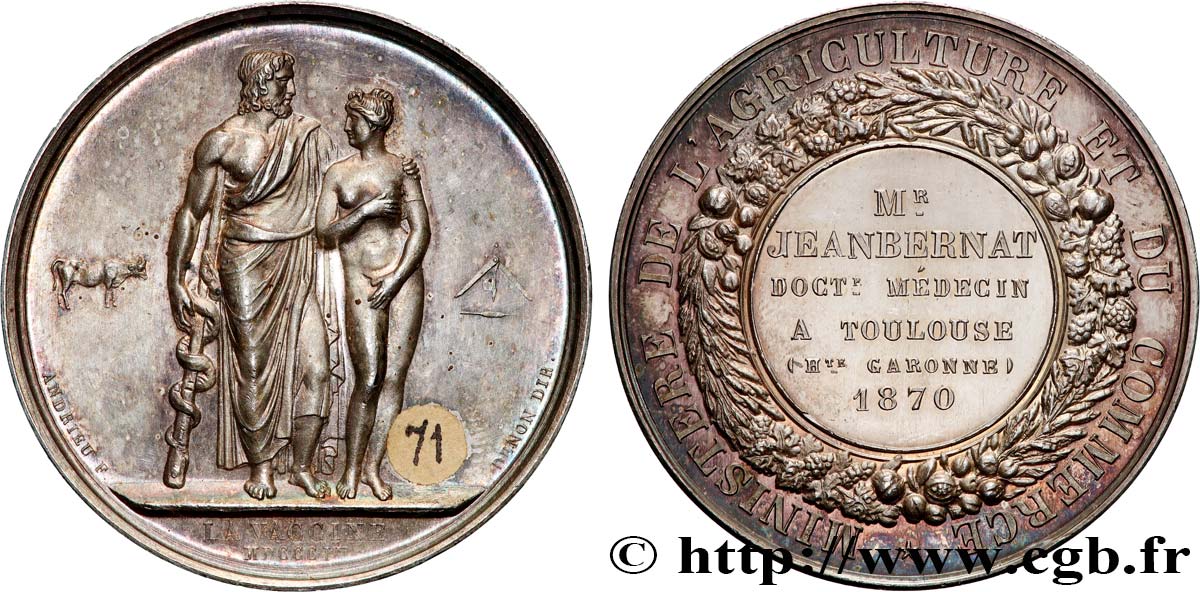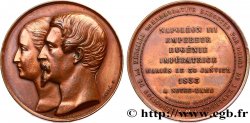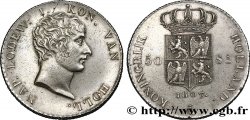Live auction - fme_876885 - SECOND EMPIRE Médaille, La Vaccine, Ministère de l’agriculture et du commerce
You must signin and be an approved bidder to bid, LOGIN TO BID. Accounts are subject to approval and the approval process takes place within 48 hours. Do not wait until the day a sale closes to register. Clicking on "BID" constitutes acceptance of the terms of use of cgb.fr private live auctions.
Bids must be placed in whole Euro amounts only. The sale will start closing at the time stated on the item description; any bids received at the site after the closing time will not be executed. Transmission times may vary and bids could be rejected if you wait until the last second. For further information check the Live auction FAQ
All winning bids are subject to a 18% buyer’s fee.
All winning bids are subject to a 18% buyer’s fee.
| Estimate : | 100 € |
| Price : | 60 € |
| Maximum bid : | 60 € |
| End of the sale : | 14 November 2023 16:52:23 |
| bidders : | 3 bidders |
Type : Médaille, La Vaccine, Ministère de l’agriculture et du commerce
Date: 1870
Mint name / Town : 31 - Toulouse
Metal : silver
Diameter : 41 mm
Orientation dies : 12 h.
Engraver ANDRIEU Jean-Bertrand (1761-1822)
Weight : 38,54 g.
Edge : lisse + abeille ARGENT
Puncheon : Abeille (1860 - 1880) ARGENT
Coments on the condition:
Jolie patine grise hétérogène, légèrement irisée. Petite usure sur les hauts reliefs. Présence de quelques rayures. Papier collé à l’avers
Obverse
Obverse legend : LA VACCINE / MDCCCIV.
Obverse description : Esculape prenant sous sa protection la Vénus de Médicis dont le bras gauche est entouré d’un bandage ; de part et d’autre dans le champ, une vache et une lancette avec un tube de vaccin. Signé : ANDRIEU F. et DENON DIR..
Reverse
Reverse legend : * MINISTÈRE DE L’AGRICULTURE ET DU COMMERCE, LÉGENDE CIRCULAIRE // M.R / JEANBERNAT / DOCT.R MEDECIN / A TOULOUSE / (H.TE GARONNE) / 1870.
Reverse description : Légende circulaire et en 6 lignes dans un médaillon entouré d’une couronne composite.
Commentary
Médaille décernée au docteur médecin, Monsieur Jeanbernat.
Cet avers est une réutilisation d’une médaille de Napoléon Ier, datée de 1804. Ce type est donc utilisé pour Napoléon Ier, Louis XVIII, probablement Chales X et aussi Louis-Philippe. Sous la seconde République et sous le Second Empire, ce type de revers est encore utilisé en guise de droit associé à un revers du Ministère de l’Agriculture et du Commerce ou encore du Ministère de l’Agriculture du Commerce et des Travaux Publics.
La vaccine, communément appelée « variole de la vache », est une maladie infectieuse des bovidés (Cowpox) et des équidés (Horsepox).
Le 11 mai 1800 naît le Comité central de vaccine. Dès 1804, Napoléon fonde la Société pour l’extinction de la petite vérole par la propagation de la vaccine..
Cet avers est une réutilisation d’une médaille de Napoléon Ier, datée de 1804. Ce type est donc utilisé pour Napoléon Ier, Louis XVIII, probablement Chales X et aussi Louis-Philippe. Sous la seconde République et sous le Second Empire, ce type de revers est encore utilisé en guise de droit associé à un revers du Ministère de l’Agriculture et du Commerce ou encore du Ministère de l’Agriculture du Commerce et des Travaux Publics.
La vaccine, communément appelée « variole de la vache », est une maladie infectieuse des bovidés (Cowpox) et des équidés (Horsepox).
Le 11 mai 1800 naît le Comité central de vaccine. Dès 1804, Napoléon fonde la Société pour l’extinction de la petite vérole par la propagation de la vaccine..








 Report a mistake
Report a mistake Print the page
Print the page Share my selection
Share my selection Ask a question
Ask a question Consign / sell
Consign / sell
 Full data
Full data















